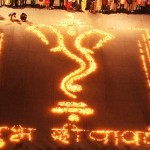They say, gratitude is mankind’s greatest virtue. So, bring home the largest pumpkin, roast the biggest of turkeys, or feast over a potful of desi savories with friends and family, because Mother Nature has offered her bounty to us - so needy and hence, so grateful. Here, comes the month of harvest and the time to reap the fruits of hard work and toil, and thus, comes the time to be grateful and to celebrate Thanksgiving. A tradition dating back to the 16th century, Thanksgiving is originally celebrated on the theme of prayers to the almighty for the harvest; instilling humility and grace in humanity in the return of immeasurable gifts we have received from God.
All across the world Thanksgiving is celebrated in different ways with different names but the Indians do it in their quintessential larger than life style, with vivid tradition and colors. Indians have a weakness for making festivals a gala affair for sure. The dates might not coincide with the Thanksgiving in the west, but purpose and intent for sure is alike, here in India. Let’s dig deeper to know how we Indians celebrate our own version of Thanksgiving across different states:
Lohri, Punjab
Punjab is the ‘bread basket’ of India, and home to the most colorful and flamboyant community. With the major share of population, directly or indirectly, related to farming ‘Lohri’ holds special significance in Punjab. Celebrated every year on the 13th of January, the festival marks the resting period before the harvest of wheat crop. Children can be seen demanding lohri loot door-to-door, singing praises of Dulha Bhatti, a local hero with folklores similar to that of Robin Hood. In the evening, a bon fire ritual takes place in which offerings like thawed rice, puffed corn are made to the fire while going around it. The offerings are made as prayers to bless the land and people with prosperity and honor. The people perform traditional dances of bhangra(men) and gidda(women) on the beats of dhol. The festival clearly celebrates fertility, abundance and joy of life. The traditional meal is of makke di roti(multi-millet hand-rolled bread) sarson da saag (cooked mustard herbs) relished with family and community.
When: January
Ladainha, Goa
The ‘Ladin’ festival is a very popular festival amongst Goan Christians. This is the closest version of western Thanksgiving you would find in India. The person who is blessed, or seeking blessings patronizes a feast with branco wine. Goans celebrate the day praying to the Virgin Mary, adorning family altars with flowers and decorating their houses with creepers and crotons. The whole Goan land is filled with sounds of litanies accompanied with violin, chanting of holy hymns and prayers. The festivities conclude with a special dish of soaked gram, boiled and mixed with coconut chips.
When: November
Onam, Kerala
The best time to see the Southern Indian fervor is during the time of Onam. This one is celebrated to honor the arrival of the revered and much loved king Mahabali visiting his people. It is also a harvest festival reminiscent of Kerala’s agrarian past. This ten day festival is packed with fun filled activities of games, dances, decorations and prayers of gratitude. Proudly, it opens with the royal parade, exhibiting different colors and elements of Kerala. Each courtyard is decorated with delicately carved flower carpets called Pookalam. A plethora of dishes served on a banana leaf, are the traditional meals prepared, and feasted by all Keralite households during this time. Thrikkakara temple within Kochi city is the epicenter of all the glory and gala at this time, believed to be the capital of lord Mahabali in ancient times. Tiger costume dances, ox racing, banana boat rides, all make these ten days’ festivities a sensorial delight.
When: September
Bihu, Assam
Bihu is celebrated to mark the change of seasons, which used to be celebrated for over a month in its ancient era dating back to 3,500 B.C. Its celebration is limited to a week now. Bihu, the word means to ‘ask and give’ which represents offering the first crops to God who gave the gift of abundant harvest to the lands and people. The festival begins with preparing the ground for paddy and commencement of various celebrations, local delicacies like pitha, jolpan, larus(rice and coconut) add on to the gastronomical offerings. On the beats of Dhol(Drum),Taal, and Pepa (An instrument made of buffalo horn) men and women sing bihu folk songs and dance the famous bihu dance form in their vibrant outfits and high spirits.
When: January
Pongal, Tamil Nadu
Pongal is the harvest festival of the Tamils, and happens to be a major festival celebrated across Tamil Nadu and Puducherry. The word Pongal means ‘overflowing’ and signifies abundance and prosperity. This festival is a dedication to the Sun God to express appreciation and heartfelt gratitude for being the source of agriculture and good harvest. A traditional ritual during this festival is to boil milk in a new clay pot with the sunrise and rejoice its boiling to pave way for new opportunities, and good future. This dish is also called ‘Pongal’. Tamil households are beautifully decorated using banana and mango leaf decorations, and floor designs beautifully drawn using rice flour. During the three day festival people visit their families and friends, express gratitude towards the cattle for their hard work and cooperation. They focus on new and fresh beginning, while discarding the past for hopes of a bright and promising future.
When: January
Makar Sankranti, North India
Makar Sankranti is an important harvest festival to Hindu traditions. It commemorates the harvest season in India. It is one of those very few Hindu dates that coincide with the Gregorian calendar. The festival celebrates the entering of sun from the northern hemisphere to the other. Makar Sankranti is treated as an extremely auspicious day by Hindus. People take early morning dips in the Ganges, wear new clothes, and perform holy rituals. It is highly characterized by the kite flying festival across the nation, in which people participate with zeal and flare.
When: January
Vaisakhi, Punjab and Haryana
This festival holds high importance for the Sikh community, it is also known as the founding day of ‘khalsa’ by the 10th Sikh guru, Guru Govind Singh. Vaisakhi is the day when farmers pay their tribute to Gods and thank them, for the sumptuous harvest and future prosperity. The festival is celebrated with pomp and show, and there are various fairs across Punjab and Haryana, where people buy jewelry and dress up in new clothes and enjoy various cultural programs and dances.
When: April
Now, since we are acquainted with our own ways of celebrating the famed Thanksgiving, we must try to bring the ‘thanks’ and ‘giving’ together by celebrating, and forget not, to count our blessings…
Shilpa Ahuja
Latest posts by Shilpa Ahuja (see all)
- Tequila, Cheddar And 10 More Such Delicious Places To Plan Your Next Trip To - April 16, 2021
- From Dhoni To Dhawan: 11 Cricket Celebs And Their Honeymoon Destinations - March 22, 2021
- LOL! 14 Hilarious Truck Signs That Will Leave You In Splits - March 18, 2021


















